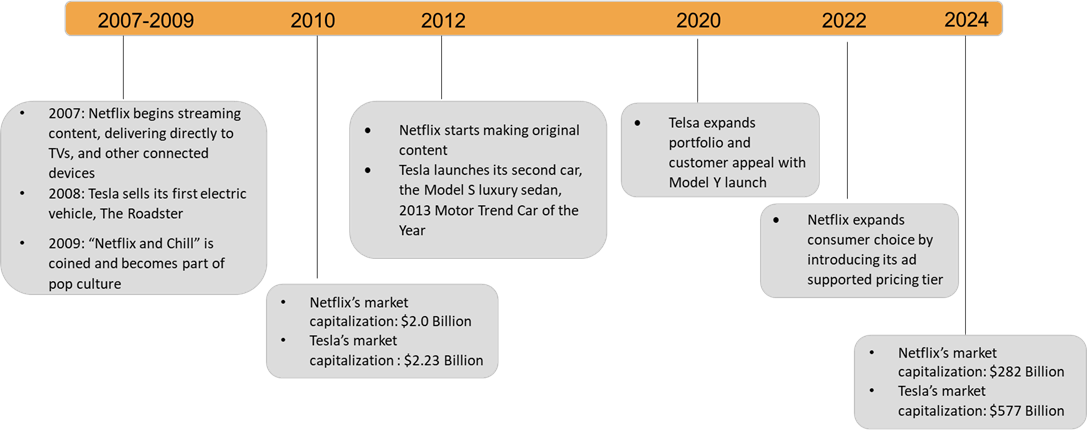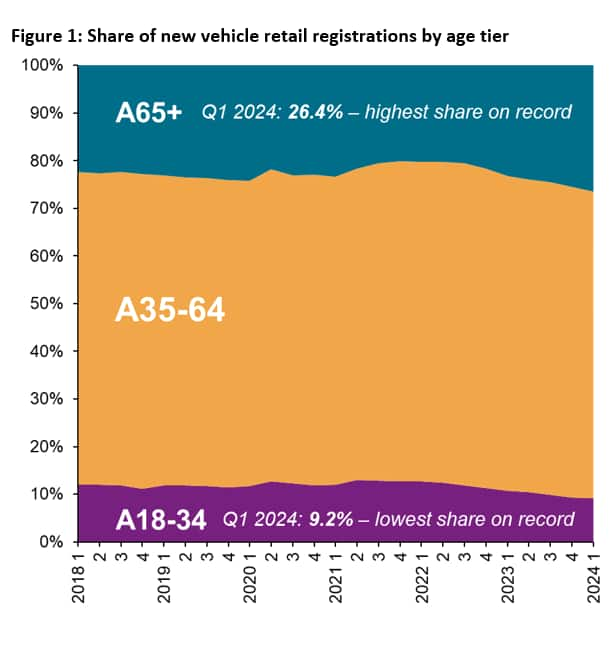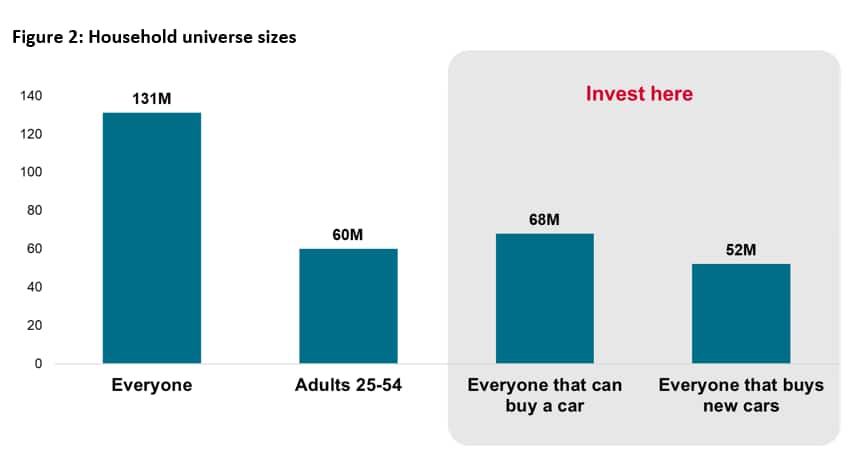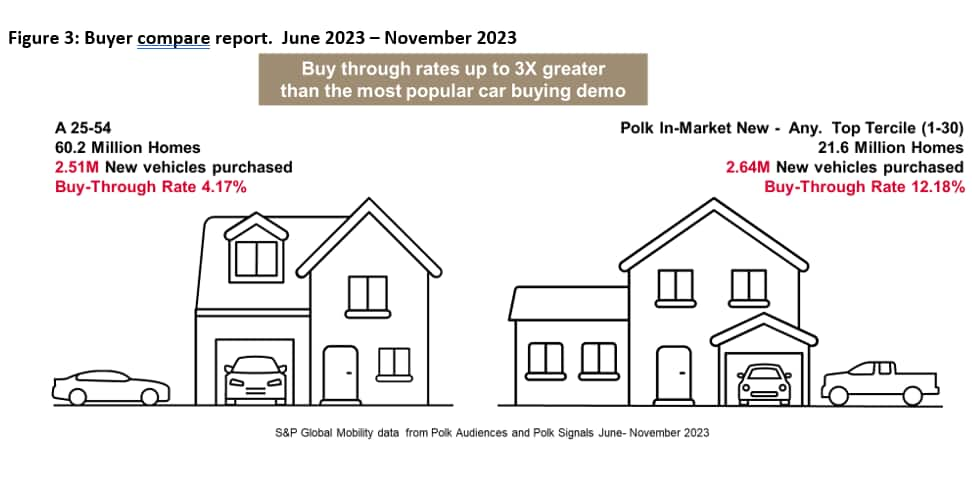Age-based buying is no longer an efficient way to drive
revenue and grow auto sales.
The media and automotive industries have long had a mutually
beneficial relationship. The Fall TV season was built to align with
new vehicles coming to market each year. This season gave
automotive marketers large swaths of the prized 25- to 54-year-old
consumer base to reach and generate awareness for new vehicle
launches. The advertising dollars spent in turn funded TV content
creation through massive upfront media investments for ads and
product integrations.
Both of these industries are now undergoing massive
transformation and upheaval in response to technology, consumer
behavior and new competitors. Look at this timeline from two
disruptors — Netflix and Tesla — that are now marketplace
leaders:

Fragmented media, fragmented data and more customer
choice
More content, more vehicle types and more connection points =
more options for what consumers drive and watch. Consumer
opportunities and choice continue to expand, placing greater
pressure on marketing budgets. Consider this:
- Today, consumers have 450 nameplates to shop. As the
electrification transition continues, that number will rise 30% to
nearly 650 nameplates by the end of the decade.- In 2016, there were 455 scripted TV series. That jumped 32% to
600 in 2022, according to Variety and Statista.
- In 2016, there were 455 scripted TV series. That jumped 32% to
- Automotive industry brand loyalty sits at 53% (April 2024).
It's up four points from its historical low, yet nearly five-in-ten
new vehicle buyers will leave their current brand with their next
purchase. - The cost of new vehicle ownership is up 30% since 2019. Only
14% of registered vehicles have an MSRP below $30,000 today. This
was 50% seven years ago.
Demographic buying no longer an efficient way to drive
revenue and grow sales.
As cost of ownership increases, younger buyers are getting
priced out of new vehicle consideration. Share of new vehicle sales
by the coveted 18- to 34-year-old demographic has dropped to 9.2%,
its lowest share on record. Meanwhile, the 65+ crowd has more
purchasing power than ever before, surpassing 26% of new vehicle
sales, its highest share on record (Figure 1). How
many new car launches are targeting the 65+ demographic?

Targeting: Advanced audiences for better results
S&P Global Mobility data provides an overview on the size of
the US automotive market today. There are roughly 131 million
households in the US. (Figure 2)
- 68 million households can buy a car
- 52 million households can buy new cars
- 50 million households DON'T buy cars
Being able to target the 52% of US households with car-buying
potential while limiting the waste with the 50 million households
that don't buy cars is where automotive marketers are going to
start maximizing their return-on-ad-spend (ROAS).

We can take this a step further and look at buy-through rates
and sales performance from the most popular automotive buying
demographic of adults ages 25 to 54 and compare that to an advanced
audience of in-market households (0-12 months) for a new vehicle
(Figure 3).

The 60 million households with adults aged 25 to 54 bought 2.51
million new vehicles over a 6-month period, a purchase rate of
4.17%. Comparably, the in-market for new vehicle segment represents
21.6 million homes that purchased 2.64 million vehicles for a
buy-through rate of 12.18%. That's 3x greater efficiency and the
same impact to sales.
The takeaway: Maximizing sales and buy-through rates by
identifying and targeting the households that are ready and able to
buy is the realized value of
Polk's advanced audiences.
Measuring outcome over output
Business outcomes are crucial for assessing the success of your
marketing investment. Savvy marketers are prioritizing campaign
measurement solutions that deliver real-times sales lift and
buy-through rates over options that rely on click stream behavior
proxy metrics, like site visits and content views.
Polk Signals data allows marketers to see total sales impact
— for themselves and the competition — getting actionable
insights that lead to smarter strategies and better decisions.
Using real-time sales data for optimization allows marketers to
analyze data mid-flight and shift toward best-performing media,
reducing waste and improving KPIs like cost-per-vehicle sale and
target buy through rates.
More choice and change are coming
S&P Global Mobility projects more than 130 new vehicle
launches in the next two years — and more than half will be for
EVs. As automotive and media industries navigate the bumpy paths to
electric vehicle and alternative TV currency adoption, marketers
can be taking these measures to mitigate waste and maximize
performance:
- Increase development and use of advanced audiences that focus
on in-market shoppers and decrease the reliance on demo-based
buying. - Buy more addressable media. The higher perceived cost can be
more than justified by higher ROI and ROAS. - Prioritize business outcomes like sales lift and buy-through
rates as core metrics for in-flight optimization and campaign
ROI.
From launching new vehicles to targeting specific customers with
a customized service offer, automotive marketing has always
employed a large arsenal of tactics to engage customers and drive
dealership traffic. The available tools are getting better now,
leveraging technology and data science to develop advanced
audiences, messaging strategies, improved digital communications
and more robust measurement solutions.
These are going to be critical for success because automotive
marketers will have to manage more customer types, vehicle types,
connection points, and buying motivations — all while making
sure they don't pass by any more customers outside that 25- to
54-year age range.
Learn more about Polk Audiences.
Sign up for the Polk Automotive Solutions newsletter.
Authored by David Kaufman, Sales and Customer Care Executive
Director, and Jason Jordhamo, Product Management Director, S&P
Global Mobility.














